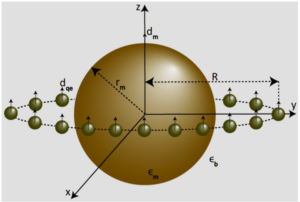
A metal nanoparticle (MNP) coupled to a quantum emitter (QE) is a versatile composite nanostructure with unique chemical and physical properties which has been studied intensively, owing to its vast range of promising applications in nanoscience and nanotechnology. When pumped into a higher gain level, an MNP-QE composite nanostructure functions as a nanoplasmonic counterpart of a conventional laser, which is capable of operating at subwavelengths. The theory of plasmonic lasers is hitherto developed on the local optical response of the MNP, disregarding the nanoscale effects of its free electrons. In this paper, we perform a comprehensive quantum mechanical analysis of a complex MNP-QE composite nanostructure, capturing the size-dependent nonclassical effects through the nonlocal optical response of the MNP.
Our study reveals that the nonlocal correction introduces significant deviations to the plasmon statistics of the hybrid particle suggested by the local calculations, becoming more prominent when the number of QEs coupled to the MNP increases. Furthermore, for the typical material parameter values used in the literature, we observed the initiation of quenching effects at lower pumping rates than suggested by the local response formalism. In essence, nonlocally assessed plasmon statistics of MNP-QE composite nanostructures demand the concerted coupling of an even higher number of QEs to compensate the deterioration in coherence and to sustain lasing.
The work is supported by the Monash University Institute of Graduate Research and the computational resources by Monash University through the NCI NF Partner allocations.